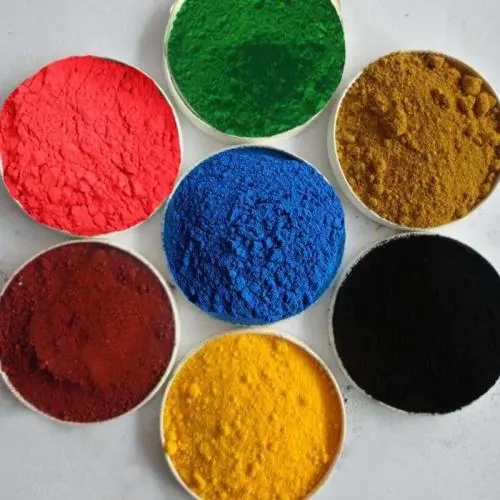What are inorganic pigments:
Inorganic pigments refer to compounds extracted from natural colorants such as minerals or ore through chemical processes. They are often complex mixtures in which metal is part of the molecule. Such as: the extraction of black, brown, white, red, yellow, brown and other colors common in primitive cave art. Charcoal or soot is the basic black material. Kaolin and chalk are made into white. Yellow, orange, and red are directly derived from Natural soil, various chromatic soils and hematite will produce deep red, yellowish brown and other colors after roasting.
Features of inorganic pigments:
Inorganic pigments are characterized by high hiding power, good light resistance, heat resistance and color migration resistance. But the density is large, the refractive index is large, the particles are larger, and The color brightness is not high.
Nowadays, the domestic and foreign construction materials, coatings and paints, plastics, inks and other industries are growing rapidly, and the demand for inorganic pigments is also rapidly increasing. With the rapid development of the coatings industry, inorganic pigments, as one of its main raw materials, have achieved considerable development, of which titanium dioxide and iron oxide account for the largest proportion.
Improving the environmental protection and safety level of inorganic pigments and achieving lead-free has been widely recognized by enterprises in the industry, and the development direction of environmentally friendly inorganic pigments is the general trend.
Classification of inorganic pigments:
Inorganic pigments are usually classified according to production method, function, structure and color.
1. According to the production method, the pigments can be divided into natural inorganic pigments (such as cinnabar, verdigris and other mineral pigments) and synthetic pigments (such as titanium white, iron red, etc.).
2. According to the function, it can be divided into four types: coloring pigments, anti-rust pigments, extender pigments and special pigments (such as high temperature pigments, pearlescent pigments, fluorescent pigments, etc.).
3. According to the chemical structure, it can be divided into iron series, chromium series, lead series, zinc series, metal series, phosphate series, molybdate series, borate series, etc.
4. According to the color, there are 5 categories: white series of pigments, such as titanium white, lithopone, zinc oxide, etc.; black series of pigments, such as carbon black, iron oxide black, etc., can be used for heat-resistant engineering plastics; yellow series of pigments, Such as chrome yellow, iron oxide yellow, cadmium yellow, titanium yellow, etc., can be used in various thermoplastic and thermosetting plastics with wide adaptability; series of pigments, such as iron red, molybdenum chrome red, cadmium red, etc.; green series of pigments, such as chromium oxide Green, lead chrome green, etc.; blue series of pigments: iron blue, ultramarine blue, cobalt blue, etc.

